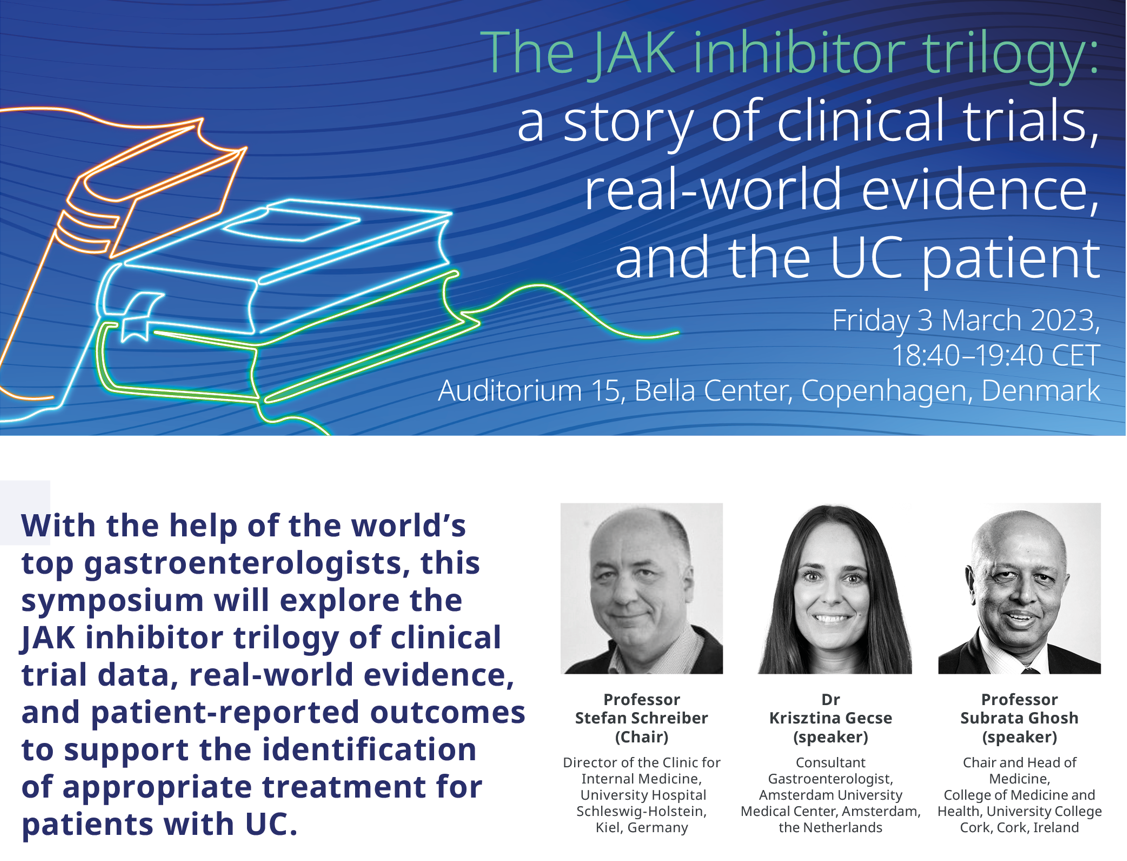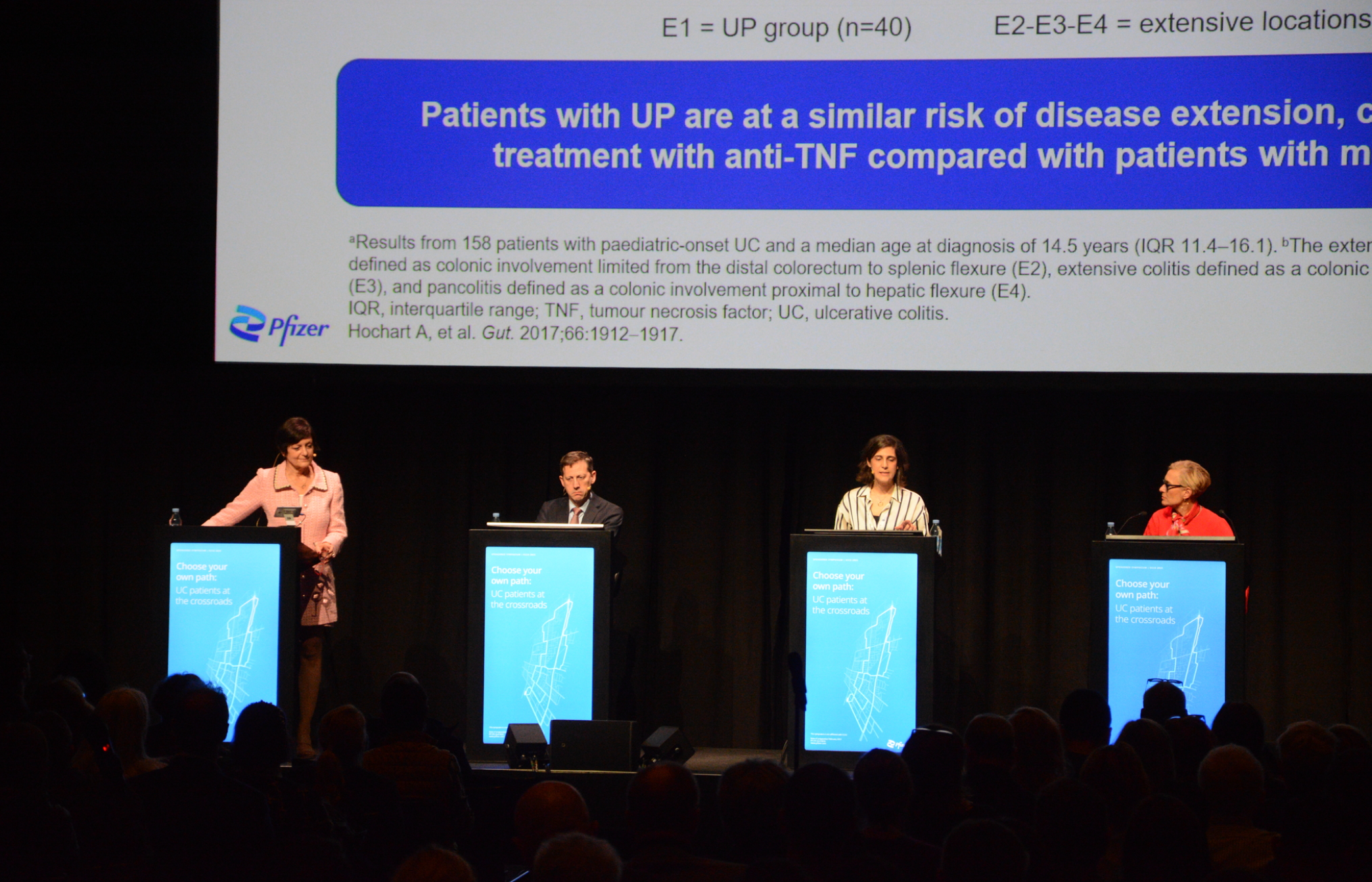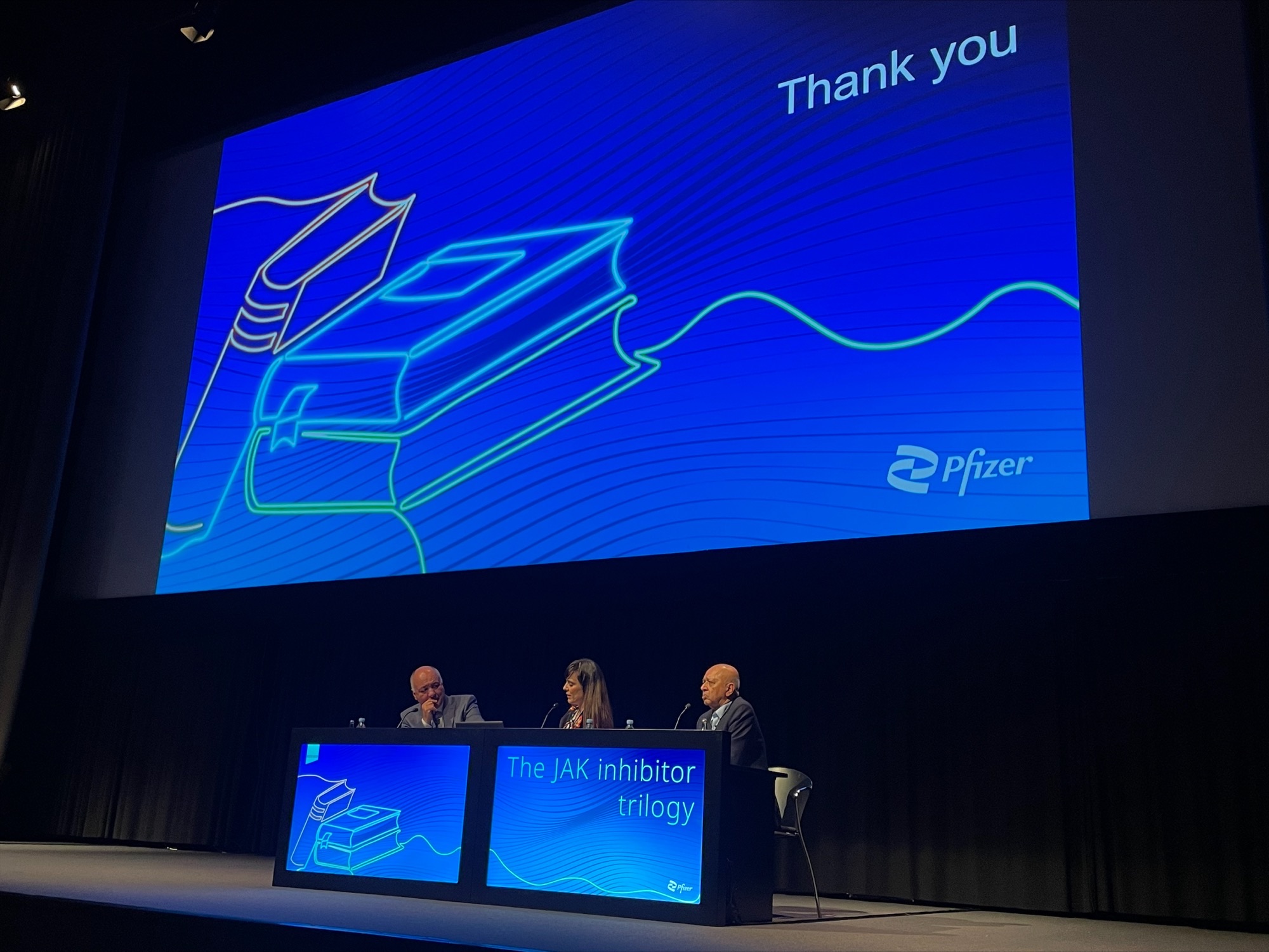Pfizer’s ECCO symposia highlights
THIS SYMPOSIUM WAS SPONSORED BY Pfizer Inc.
 |
This March, the highly anticipated Pfizer symposia at ECCO 2023 delivered interesting, engaging, and thought-provoking updates for the treatment of patients with Ulcerative Colitis (UC).
The first of the two symposia took place on Thursday 2 March, as we asked delegates to join us at the crossroads in UC patient care. The ‘Choose your own path: UC patients at the crossroads’ symposium provided an engaging and interactive experience, led by distinguished faculty members Dr Peter Irving, Dr Joana Torres, Dr Maria T Abreu, and Dr Iris Dotan. Delegates entered the symposium hall to a rocking soundtrack from The Clash, Fleetwood Mac, Blondie, and Queen: a nod to the music stars’ top hits in each of the symposium presentation titles set the tone, looking to an upbeat future for patients with UC.
The faculty kept the energy flowing as the journey through the crossroads started, beginning with Dr Irving’s ‘Should I stay or should I go: when is conventional therapy no longer enough?’. Dr Irving highlighted the levels of dissatisfaction among patients with UC receiving conventional therapies and how a high proportion of these patients do not respond, or lose response over time.1-4 The need for additional treatment options was emphasised to help physicians provide optimal care to reduce long-term irreversible bowel damage and improve patient-reported outcomes (PROs).5
In ‘Go your own way: are proctitis patients different from other patients with UC?’, Dr Torres guided us through decisions in the care of patients with Ulcerative Proctitis (UP) and provided a strong call to action for better management of these patients. We learned how UP is often considered a minor form of disease, despite these patients being at risk of proximal disease extension, diminished rectal compliance, and reduced quality of life (QoL).6-9 Dr Torres informed us how patients with refractory UP can benefit from treatment with advanced therapy.10
Dr Abreu then treated the audience to a fantastic visual analogy of the role of sphingosine-1-phosphate (S1P) and the S1P receptor (S1PR) in the pathophysiology of UC in her presentation ‘One way or another: should we target the freeway or the side streets in UC inflammation?’. Visualising T lymphocyte subsets as cars and lymph nodes as car parks, we learned that the egress of certain T lymphocyte subsets out of lymph nodes is regulated by the S1P-S1PR pathway.11, 12
The final crossroads focused on patient-preferred outcomes, with Dr Dotan’s presentation ‘I want to break free: is steroid-free remission a patient-preferred outcome?’. Corticosteroid (CS) use is concerning among patients with UC13 and most would prefer never to take CS.14 Despite these concerns, we know that patients with UC may undergo multiple cycles of CS therapy.15 Dr Dotan emphasised the importance of new and durable treatments for UC to help patients achieve steroid-free remission.16
The delegates had their say as well, participating in polling questions at the end of each presentation, which initiated lively debate and discussion among the faculty. This continued into the Q&A, during which our faculty received some insightful questions from an engaged audience. Dr Irving concluded the symposium by thanking his fellow faculty for helping guide us through these challenging crossroads in UC patient care. As a final sentiment, he noted that patients with UC will face many more crossroads on their treatment journey, through which their physicians should guide them with optimal treatment choices.

The second Pfizer symposium, titled ‘The JAK inhibitor trilogy: a story of clinical trials, real-world evidence, and the UC patient’, took place on Friday 3 March, during which the story of JAK inhibitors was shared. The symposium was led by a distinguished faculty including Professor Stefan Schreiber, Dr Krisztina Gecse, and Professor Subrata Ghosh, who provided a thought-provoking narrative on the latest clinical and real-world evidence (RWE) for Janus kinase (JAK) inhibitors in UC.
Professor Schreiber guided the audience through the first chapter, ‘The evolution of a breakthrough: the story of JAK inhibitors in the past 10 years’, and explained the JAK inhibitor mechanism of action and implications for JAK inhibitor class selectivity. JAK inhibition reduces gene transcription of inflammatory mediators by modulating cytokine signalling within the cell.17-19 With this in mind, it is important to understand JAK inhibitor selectivity in the context of clinically relevant doses for UC, which can only be determined through monitoring use in patients.20-25 Professor Schreiber introduced tofacitinib, which was the first JAK inhibitor to be FDA approved for the treatment of rheumatoid arthritis20, 26 and has been additionally approved for UC, psoriatic arthritis, ankylosing spondylitis, and juvenile idiopathic arthritis.27 Thirteen phase 3 clinical trials have evaluated the efficacy and safety of tofacitinib across these five indications. Several RWE studies across the world have also assessed effectiveness, safety, and PROs with tofacitinib treatment in UC.20, 27
‘The plot thickens: determining the appropriate treatment for the UC patient’: in this fascinating chapter, Dr Gecse discussed how to determine the appropriate treatment for patients with UC through a case study. The audience shared their opinions via polling on what class of medicines they would choose for this case. The efficacy and safety data of tofacitinib were then reviewed, revealing its rapid onset of action and durable maintenance of remission.28-31 In addition, tofacitinib’s well-characterised safety profile was highlighted, with up to 7.8 years of long-term safety data reported.31 Dr Gecse also brought our attention to the non-invasive methods for patient monitoring; a recent RWE study showed that intestinal ultrasound is accurate when compared with endoscopy for detecting treatment response in patients with moderate to severe UC.32
Turning the page to our next chapter: ‘UC in the first person: what can we learn from the evidence and patient-reported outcomes?’. Particular emphasis was given to the role of diet and microbiome in managing patients with UC via a case study followed by a polling session. Professor Ghosh highlighted the importance of maintaining a healthy diet rich in high-fibre foods as an effective strategy for reducing the risk of Inflammatory Bowel Disease (IBD) and improving disease states, as microbiota produce short-chain fatty acids that can protect the intestine from damage by interacting with macrophages.33 He also informed us that improving the health-related quality of life (HRQoL) of patients with UC is a key treatment goal for patients and physicians. Notably, tofacitinib has shown long-term improvements in HRQoL across the UC clinical trial programme.30, 34 In RWE settings, tofacitinib has been observed to improve PROs as assessed by Simple Clinical Colitis Activity Index (SCCAI) and its components, EuroQoL-5 Dimension-5 Level (EQ-5D-5L) index total score, short version of the Inflammatory Bowel Disease Questionnaire (SIBDQ) total score, and Work Productivity and Activity Impairment (WPAI) component score.35, 36
Bringing us to the end of this tale, the audience submitted a range of questions pertaining to JAK inhibitors and their application in clinical practice. This sparked an engaging discussion amongst the experts, as they delved into ways to optimise the benefit–risk assessment of JAK inhibitor treatment.

In conclusion, both Pfizer symposia at ECCO 2023 provided valuable insights into the latest advancements in understanding the pathophysiology and options for treating patients with UC.
References
-
Murray A, et al. Cochrane Database Syst Rev. 2020;8:CD000544.
-
Loftus EV, et al. Inflamm Bowel Dis. 2014;20:1361-1367.
-
Revés J, et al. Curr Res Pharmacol Drug Discov. 2021;2:100070.
-
Peyrin-Biroulet L, et al. Dig Liver Dis. 2016;48:601–607.
-
Danese S, et al. Dig Dis. 2019;37:266–283.
-
Hochart A, et al. Gut. 2017;66:1912–1917.
-
Meucci G, et al. Am J Gastroenterol. 2000;95:469–473.
-
Cleveland KN, et al. Gastroenterology. 2022;162:331–333.e1.
-
Caron B, et al. Gut. 2021;70:1203–1209.
-
Dubois E, et al. United European Gastroenterol J. 2020;8:933–941
-
Peyrin-Biroulet L, et al. Autoimmun Rev. 2017;16:495–503.
-
Olivera P, et al. Gut. 2017;66:199–209.
-
Rubin DT, et al. Inflamm Bowel Dis. 2021;27:1942–1953.
-
Hagelund LM, et al. Curr Med Res Opin. 2020;36:771–779.
-
Siegel CA, et al. Clin Transl Gastroenterol. 2020;11:e00128.
-
George J, et al. Inflamm Bowel Dis. 2020;26:515–523.
-
O'Shea JJ, et al. N Engl J Med. 2013;368:161–170.
-
Hodge JA, et al. Clin Exp Rheumatol. 2016;34:318–328.
-
Mavers M, et al. Curr Rheumatol Rep. 2009;11:378–385.
-
Choy EH. Rheumatology (Oxford). 2019;58:953–962.
-
Parmentier JM, et al. BMC Rheumatol. 2018;2:23.
-
Mohamed MF, et al. J Clin Pharmacol. 2020;60:188–197.
-
Kameda H, et al. Arthritis Res Ther. 2021;23:9.
-
Nader A, et al. Clin Pharmacol Ther. 2020;107:994–1003.
-
Traves PG, et al. Ann Rheum Dis. 2021;80:865–875.
-
Winthrop KL. Nat Rev Rheumatol. 2022;18:301-304.
-
XELJANZ (tofacitinib citrate) Summary of Product Characteristics. Pfizer Inc. September 2022. https://www.ema.europa.eu/en/documents/product-information/xeljanz-epar-product-information_en.pdf. (accessed March 22, 2023).
-
Hanauer S, et al. Clin Gastroenterol Hepatol. 2019;17:139–147.
-
Sandborn WJ, et al. Clin Gastroenterol Hepatol. 2022;20:591-601.e8.
-
Sandborn WJ, et al. N Engl J Med. 2017;376:1723–1736.
-
Sandborn WJ, et al. J Crohns Colitis. 2022;jjac141.
-
de Voogd F, et al. Gastroenterology. 2022;163:1569–1581.
-
O'Mahony C, et al. Int J Mol Sci. 2022;23.
-
Biedermann L, et al. Inflamm Bowel Dis. 2022;izac222.
-
Armuzzi A, et al. BMC Gastroenterol. 2023;23:17.
-
Long MD, et al. Inflamm Bowel Dis. 2022;izac121.
PP-XEL-GLB-1635. PP-IPE-GLB-0057.
22 March 2023. www.pfizer.com ©2023 Pfizer Inc. All rights reserved.
Disclaimer: This programme is not affiliated with ECCO.


